Menus
- Beauties among themselves
- And the MV Agusta F4 RC?
- How well do the rest of the electronics on the superbike work?
- Technical specifications
- MV Agusta F3 800 RC
- MV Agusta F4 RC
- Technology of the MC Agusta F4 RC
- judgment
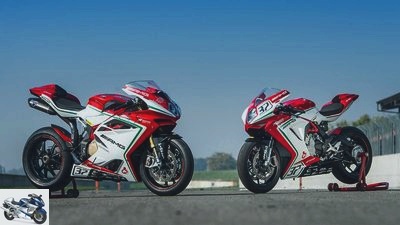
MV Agusta
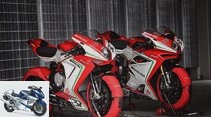
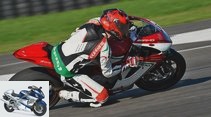
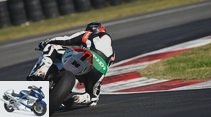

25th photos
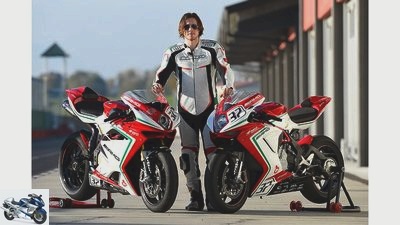
MV Agusta
1/25
With the limited models F3 RC and F4 RC, MV Agusta offers the WM basic models for sale. But looking good is not enough, ladies (and Tobi). So off to the slopes and show what’s possible.
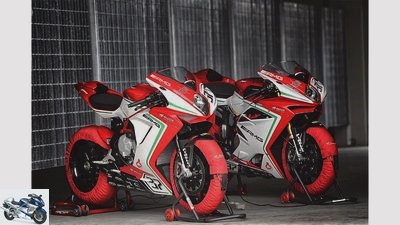
MV Agusta
2/25
How do the MV Agusta F3 RC (front) and MV Agusta F4 RC differ?
According to the data: 148 HP against 212 HP, 173 kg against 175 kg (each dry) and 17,090 euros against 36,900 euros.
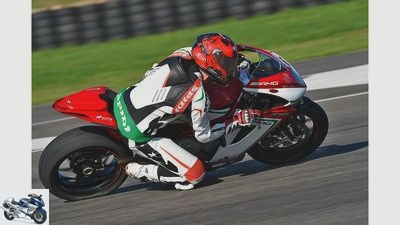
MV Agusta
3/25
MV Agusta F3 800 RC.

MV Agusta
4/25
With the three side-mounted exhaust pipes, the MV Agusta F3 800 RC outrageously shows its pretty backside.

MV Agusta
5/25
The MV Agusta F4 RC, on the other hand, shows what it has and carries its rear silencer directly under the rear.
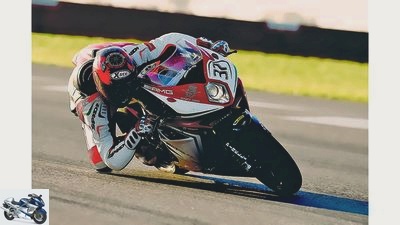
MV Agusta
6/25
MV Agusta F4 1000 RC.

MV Agusta
7/25
Treasure chest for F4 RC buyers: In addition to the Termignoni system and other accessories, it contains that of company boss Giovanni Castiglioni
signed certificate of authenticity.
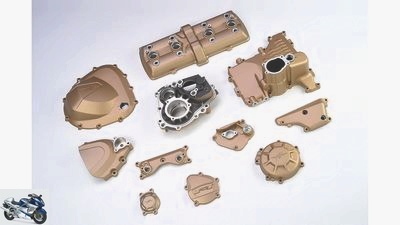
MV Agusta
8/25
To save weight, all motor housing parts are made of a magnesium alloy.
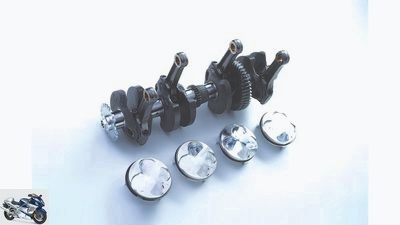
MV Agusta
9/25
Many steel parts have undergone fine machining, including the crankshaft, connecting rods, pistons, parts of the transmission.
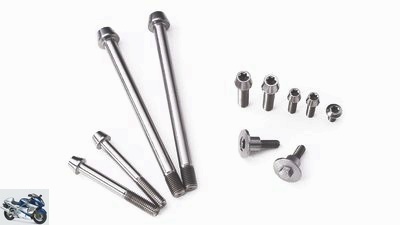
MV Agusta
10/25
All bolts and screws are made of stable yet lightweight titanium. This makes a total of minus 1.1 kilograms compared to conventional steel.
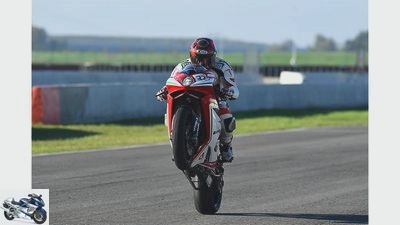
MV Agusta
11/25
Conclusion: Fans of the manufacturer from Varese can buy an exclusive piece of MV history with the MV Agusta F3 RC. However, the standard model is financially more attractive and technically just as good. The situation is different with the MV Agusta F4 RC. What a crazy engine, what a crazy sound! In addition, the noble components and the fine workmanship. Despite its quirks, you have to love the F4 RC.
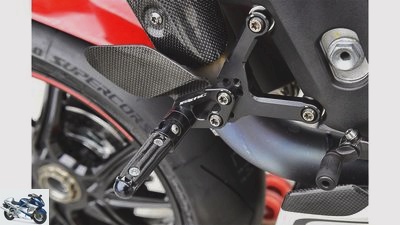
MV Agusta
12/25
Footrest system with lettering of the MV Agusta F4 RC.

MV Agusta
13/25
Swedish gold on the stern of the MV Agusta F4 RC.
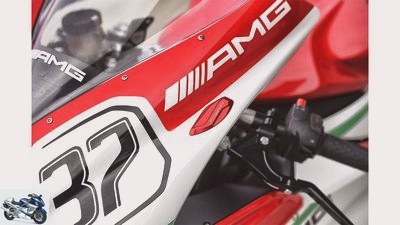
MV Agusta
14/25
If the mirrors are removed, the resulting gaps can be filled with fine aluminum parts.
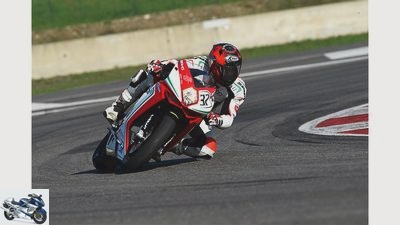
MV Agusta
15/25
MV Agusta F3 800 RC.
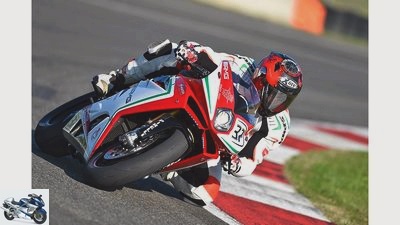
MV Agusta
16/25
MV Agusta F4 RC.
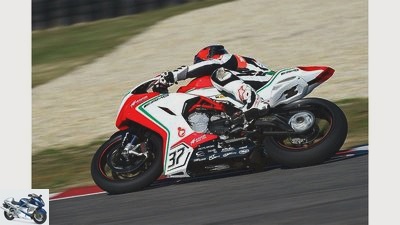
MV Agusta
17/25
MV Agusta F3 800 RC.
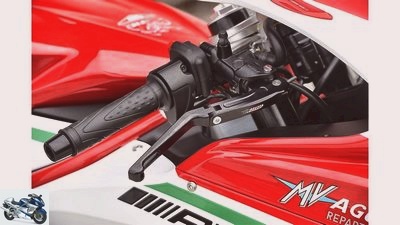
MV Agusta
18/25
Foldable and multi-adjustable aluminum levers are part of the optional equipment of the MV Agusta F3 RC.
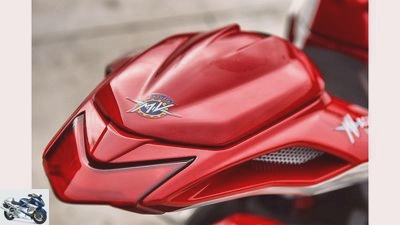
MV Agusta
19/25
It’s the finely drawn lines and details that make an MV Agusta
turn off. The RC model of the F3 comes with an extra passenger cover.
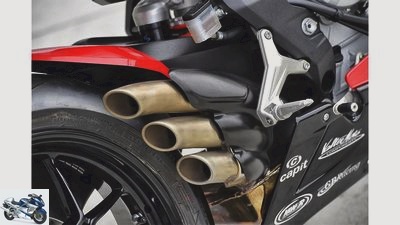
MV Agusta
20/25
The flute exhaust symbolizes the three cylinders of the MV drive. But only the aluminum footrests with a particularly handy, non-slip structure are new.
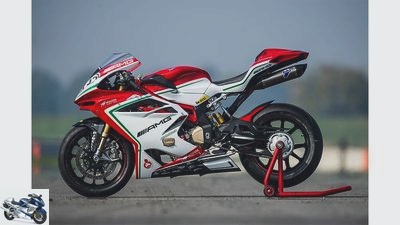
MV Agusta
21/25
MV Agusta F4 RC.
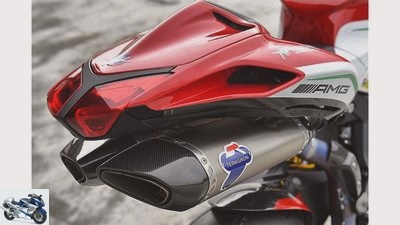
MV Agusta
22/25
Mamma mia! Through the open Termignonis of the MV Agusta F4 RC there is a background noise like an old Ferrari racing car. You won’t forget this sound anytime soon.
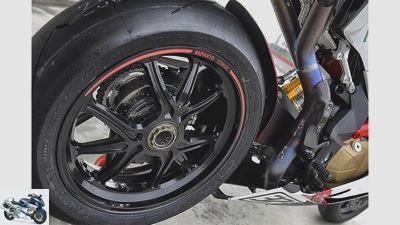
MV Agusta
23/25
Lightweight construction and elegant appearance. The forged aluminum wheels were specially developed and designed for the 1000 MV Agusta.
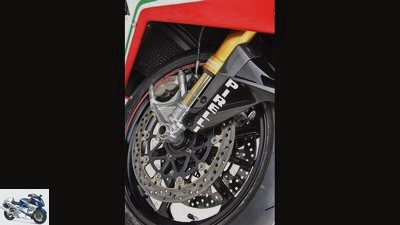
MV Agusta
24/25
No compromises on the braking system. The Brembo M50 monoblocks bite poisonously and finely dosed. Late anchoring is a prime discipline of the MV Agusta F4 RC.
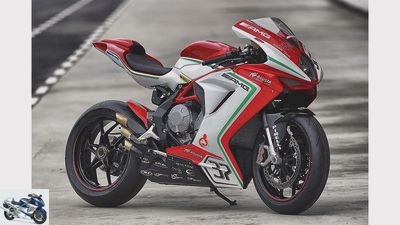
MV Agusta
25/25
MV Agusta F3 800 RC.
MV Agusta F3 RC and MV Agusta F4 RC in the HP driving report
Beauties among themselves
Content of
With the limited models MV Agusta F3 RC and MV Agusta F4 RC, MV Agusta offers the World Cup basic models for sale. But looking good is not enough, ladies. So off to the slopes!
Italy, at the end of October this autumn. An inconspicuous truck stands in the fog-shrouded paddock of a smaller racetrack south of Milan. The sliding door of the van opens and reveals a glimpse of the valuable cargo: there are only 350 MV Agusta F3 RCs worldwide, divided into 250 eight hundred and 100 sixty-five. From the MV Agusta F.4 RC were only produced 250 pieces. While you get your mouth dry when you look at the price for the 800 of 17,090 euros, the hammer goes down completely when you find out the amount that MV Agusta is asking for the superbike. The device costs 36,990 euros and has loads of the finest materials and finest components. Who will buy something like this? Well, there are enough financially strong collectors and enthusiasts. The machines are not sold out yet, but almost.
Buy complete article
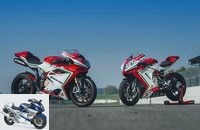
MV Agusta F3 RC and MV Agusta F4 RC in the HP driving report
Beauties among themselves
Like a 600 with a good portion more bang
Let’s make it short. With all the consequences, the MV Agusta F3 800 RC drives as easily and sharply as you already know from the basic model. Thanks to the minimalist wheelbase and low weight, it tends to be a bit nervous. You can imagine it like a 600 with a good portion of more bang, but the three-cylinder retains its excellent performance characteristics despite its relatively large individual displacement.
The traction control of the MV Agusta F3 800 RC regulates the slip to level three of eight less sensitively than one is used to from other systems that also work with gyro sensor technology. The translation behavior of the electronic throttle grip to the throttle valve takes some getting used to. The feeling is always a bit vague and indirect. In connection with the “Sport” mapping, the exact dosage of power is not that easy. When accelerating on the intermediate straight, the front wheel accidentally snaps up. The “Normal” motor mapping works better. Here, too, there is full power, but less responsive and more finely adjustable. Sometimes the quickshifter pushes the gears between the gear steps and thereby brings the propulsion to a standstill. All of these quirks are known, and good tuners know effective antidotes.
And the MV Agusta F4 RC?
Only a few tuners, on the other hand, will ever get their hands on an MV Agusta F4 RC for doctoring around, because most of the specimens probably adorn home living rooms or complement exclusive collections. As a homologation basis for the Superbike World Championship, the machine is one of the fastest irons that can currently be purchased from MV Agusta. At the Circuito Tazio Nuvolari, it sweeps down the home straight as if there was no tomorrow, producing a background noise like one of those old Ferrari racing cars. The earplugs are at home on the shelf, but the fascination of the moment whitewashes the fear of impending hearing damage by far. The F4 RC with the Termignoni system and racing control unit should produce 212 hp at 13,600 rpm, both of which are included with the purchase. Over 200 hp seems credible, a performance deficit compared to established sports material – for example from Bavaria – is not recognizable.
Of course, this engine from Varese also runs with a certain basic mechanical roughness when it is stationary, the absence of which would probably alarm rather than delight brand fans. If you open the gas, the elaborately constructed four-in-line with its radially arranged valves and backpack alternator blows resolutely to attack. In the ample middle speed range, you experience a decent increase in power around 7000 rpm. A little later, the variable intake trumpets seem to switch and the MV Agusta F4 RC really gets going. From 10,000 rpm it is all about fire and the dry 175 kilogram light, magnesium and carbon equipped MV marches brutally until it runs into the limiter at around 14,000 rpm. The Varese did a really good job of this engine, Chapeau!
MV Agusta
How do F3 (front) and F4 differ? According to the data: 148 hp against 212 hp, 173 kg against 175 kg (each dry) and 17,090 euros against 36,900 euros.
Crouching behind the windshield, you will notice the incredible stability of the chassis, which distinguishes the motorcycle in curves and during hard braking maneuvers. The MV Agusta F4 RC lies as if nailed to the ground. Part of the stability is certainly due to the high-end chassis made of specially coated NIX30 fork from Ohlins including the TTX 36 shock absorber. Despite the tight basic setup, the spring elements respond well and, with one exception, provide good feedback. At least with the cool asphalt temperatures, you poke around with the front wheel when turning in the dark. Probably mainly a matter of voting. MV technician Lorenzo gives two clicks more compression plus one click more rebound damping, which improves the situation.
The age of the F4 concept is noticeable in the radii, when the machine simply no longer wants to be angled more closely and does not change course even with the anger and screeching of the driver. Without supporting gas in slow turns, the MV then shows a tendency to collapse and requires high concentration. The MV Agusta F4 RC does not particularly oppose the narrow Italian course in this discipline. On fast courses like Monza or in Spa, she and the rider would feel more comfortable, who would soon be plagued by physical fatigue. Sooner or later, the F4 RC will kill you! The same game takes place as before with the MV Agusta F3 RC: The “Normal” motor mapping is to be preferred, but the basic requirement for fast laps remains a precise driving style.
How well do the rest of the electronics on the superbike work?
The cardinal question is: How well do the rest of the electronics on the superbike work? Fortunately, quite passable. The electronic throttle of the MV Agusta F4 RC even offers a really crisp resistance, the throttle response is direct and precise. Oh look, it works! Faux pas such as a pushing motor or a traction control that only regulates the slip many meters after the apex of the curve do not occur. Nevertheless, caution is advised at least at low levels three or even one. The black lines from the previous laps show heavy rubber wear and the TC intervenes quite roughly in the action. Blind trust in this system does not want to appear. One or the other time the quickshifter also gets stuck here.
Perhaps a few years ago it would have been better to completely spare the F4 models from having to scourge electronics. Even without them, their fans would not have been less enthusiastic. Nevertheless, the systems in the exclusive F4 RC model seem to have reached a certain degree of maturity, even above that of the MV Agusta F3 RC. Nice for everyone who has a machine like this in their living room.
Technical specifications
MV Agusta
With the three side-mounted exhaust pipes, the MV Agusta F3 800 RC outrageously shows its pretty backside.
MV Agusta F3 800 RC
MV Agusta
MV Agusta F3 800 RC.
Drives
Three-cylinder in-line engine, four valves / cylinder, 109 kW (148 hp) at 13,000 / min *, 88 Nm at 10,600 / min *, 798 cm³, bore / stroke: 79.0 / 54.3 mm, compression: 13.3 : 1, ignition / injection system, 50 mm throttle valves, mechanically operated multi-disc oil bath clutch, six-speed gearbox, chain, G-Kat, TC
landing gear
Steel tubular space frame, steering head angle: 66.0 degrees, caster: 99 mm, wheelbase: 1380 mm, inner fork tube diameter: 43 mm, spring travel from / h .: 125/130 mm
Wheels and brakes
Light alloy cast wheels, 3.50 x 17 “/5.50 x 17”, front tires: 120/70 ZR 17, rear: 180/55 ZR 17, 320 mm double disc brakes with radially attached four-piston fixed calipers at the front, 220 mm single disc with Two-piston fixed caliper at the rear, ABS
Weight
(dry) 173 kg *
Tank capacity: 16.0 liters of super
Base price
17,090 euros (plus ancillary costs)
MV Agusta F4 RC
MV Agusta
MV Agusta F4 RC.
drive
Four-cylinder in-line engine, four valves / cylinder, 158 kW (212 hp) at 13,600 / min *, 115 Nm at 9300 / min *, 998 cm3, bore / stroke: 79.0 / 50.9 mm, compression: 13.4 : 1, ignition / injection system, 50 mm throttle valves, mechanically operated multi-plate oil bath clutch, six-speed gearbox, chain, G-Kat, TC
landing gear
Steel tubular space frame, steering head angle: 66.5 degrees, caster: 100 mm, wheelbase: 1430 mm, inner fork tube Ø: 43 mm, spring travel from / h .: 124/120 mm
Wheels and brakes
Light alloy cast wheels, 3.50 x 17 “/ 6.00 x 17”, front tires: 120/70 ZR 17, rear: 200/55 ZR 17, 320 mm double disc brakes with radially attached four-piston fixed calipers at the front, 210 mm single disc with Four-piston fixed caliper at the rear, ABS
Weight
(dry) 175 kg *
Tank capacity: 17.0 liters super
Base price
36,900 euros (plus ancillary costs)
* Manufacturer information
Technology of the MC Agusta F4 RC
MV Agusta
To save weight, all motor housing parts are made of a magnesium alloy
The MV Agusta F4 RC achieves the maximum output of specified 212 hp at 13,600 rpm only with the Termignoni system made of titanium and a racing control unit, which is not approved for the road. Both are included with the purchase. These accessories alone do not make the roast fat; a whole series of other changes ensure increased performance, weight savings and a particularly harmonious interaction of the individual components. The use of a magnesium alloy made the cylinder head cover, the engine housing and the covers of the clutch, chain, cassette gear, alternator, oil pan, oil filter and other small items particularly light.
MV Agusta
Many steel parts have undergone fine machining, including the crankshaft, connecting rods, pistons, parts of the transmission
Gear parts and camshafts were specially reworked in search of the last gram of weight. In addition, numerous titanium screws and bolts save a total of 1.1 kilograms. The entire fairing of the MV Agusta F4 RC is made of carbon. The bottom line is that the limited number of machines weighs 13 kilograms less than the next top model in the MV Agusta product portfolio, the F4 RR. Furthermore, the cylinder head of the RC model has modified inlet and outlet ports.
In addition, the injection nozzles are arranged on two banks and the fuel supply is optimized. Magneti-Marelli components are at work at the top, four Mikuni nozzles at the bottom. To improve the cooling, the cooling circuit works via silicone hoses.
judgment
MV Agusta
MV Agusta F3 RC and MV Agusta F4 RC.
Fans of the manufacturer from Varese can purchase an exclusive piece of MV history with the MV Agusta F3 RC. However, the standard model is financially more attractive and technically just as good. The situation is different with the MV Agusta F4 RC. What a crazy engine, what a crazy sound! In addition, the noble components and the fine workmanship. Despite its quirks, you have to love the F4 RC!
Related articles
-
Honda CB 650 F in the driving report
Photo: factory 36 photos plant 1/36 Honda CB 650 F in the driving report. plant 2/36 Honda CB 650 F in the driving report. plant 3/36 Honda CB 650 F in…
-
Driving report Yamaha XT 660 R-XT 660 X
Artist Driving report Yamaha XT 660 R / XT 660 X Comeback to the power of two The fans can breathe easy. Yamaha brings the myth XT back to life? in two…
-
MV Agusta 800 Dragster in the PS driving report
MV Agusta 24 photos MV Agusta 1/24 MV Agusta Brutale 800 Dragster MV Agusta 2/24 MV Agusta Brutale 800 Dragster MV Agusta 3/24 MV Agusta Brutale 800…
-
Driving report Royal Enfield Bullet 500
Driving report Royal Enfield Bullet 500 Holy cow N oh the Edel-Enfield from issue 11/2005, now a live report from the saddle of the standard version. It…
-
Kawasaki Z 650 in the driving report
Kawasaki 9 photos Kawasaki 1/9 Photo gallery: Kawasaki Z 650 in the driving report. Kawasaki 2/9 The diet worked: Compared to the ER-6n, the Z 650 has…
-
Driving report Benelli TnT 1130
Gori Driving report Benelli TnT 1130 Hi, that’s me! Medieval walls shake, terracotta pavement vibrates, Orvieto is in an uproar. What happens? An…
-
Artist Driving report Honda FMX 650 Fresh Clothes make the man, thought Honda, and with the stylish FMX 650 presents a few well-known components in an…
-
Driving report Honda Hornet 600
Gargolov Driving report Honda Hornet 600 Another world The completely renewed Honda Hornet 600 is brave, stylish and powerfully active. In addition to…
-
Driving report Honda CRF 1000 L Africa Twin (part 1)
Honda 13 photos ULA SERRA PRATS 1/13 Honda Africa Twin. 2/13 270 degree crank pin offset, long, continuous shaft with two balance weights in front of the…
-
Bilski Driving report Kawasaki Z 750 (2007) Cherry’s dream MOTORRAD test editor Rolf Henniges drove the brand new Z 750 in Spain. And in the process he…